The bathroom has its own microclimate, which differs from other rooms in high humidity and temperature fluctuations. This circumstance should be taken into account when choosing finishing materials. Below we will look at successful and unsuccessful types of bathroom ceilings and dwell on some of them in more detail.
We will talk about those types of coatings that are “not friendly” with the humid air of the bathroom. And then we will consider in more detail the suitable materials - their types, cost, advantages and installation features.
Requirements for finishing wet rooms
In addition to the fact that the bathroom is a room that is constantly exposed to water and steam, neighbors from above can also flood it at any time. In addition, it is subject to more rapid temperature changes. That is why the answer to the question of which ceilings are best for the bathroom requires detailed explanations.
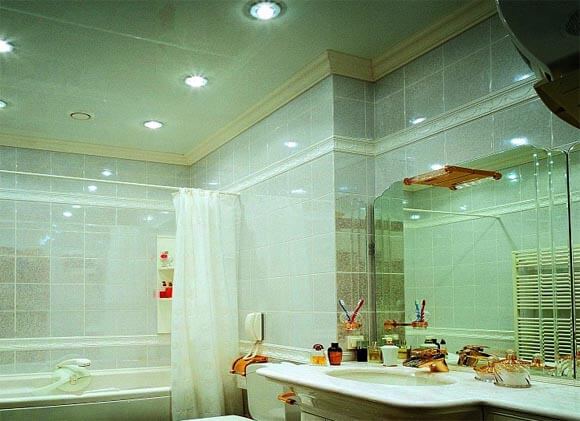
Unsuitable bathroom covers
So, first let's talk about what kind of ceiling should not be done in the bathroom.
Here is a list of not so good options:
- Whitewashing with lime. This type of coating was very popular in the recent past. But there are plenty of better options available now, many of which don't cost much more and look much better and last longer. Lime rather quickly acquires a yellowish tint. As a result, it must be periodically washed off and whitened again. And this is a waste of time and money.
- Whitewashing with chalk. This method of processing the ceiling has the same disadvantages as lime whitewash, but in addition to them, mold can settle on the chalk surface. For a bathroom, this is a completely inappropriate material.
- Oil paint or enamel. Such types of paints under the influence of moisture begin to crack, flake off and crumble.
- Wallpapering. The glue on which the wallpaper is held is saturated with moisture and ceases to fulfill its function. As a result, the coating simply falls off.
- Suspended ceiling made of materials vulnerable to moisture. These include drywall, chipboard, fiberboard. Such a ceiling will not only quickly deform and become unusable, but will also require a complete replacement if you are flooded from above.
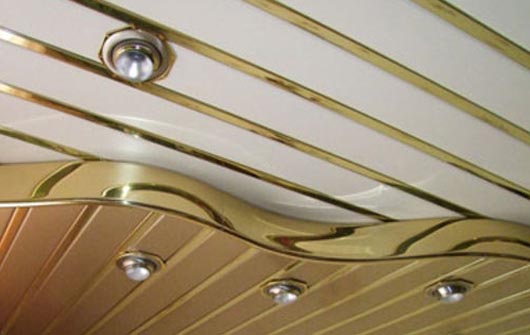
Reliable materials for the ceiling in the bathroom
Let us now dwell on those materials that are not sensitive to moist air. The modern industry offers a wide variety of ceiling options in the bathroom, which have practicality and high aesthetic qualities. You just have to choose from the whole range of possibilities the material that suits you best in terms of price and appearance.
Waterborne or latex ceiling paint
Painting allows you to beautifully finish the ceiling without reducing the height of the room. In addition to enamel and oil paint, which, as already mentioned, are not suitable for the bathroom, there are more modern compositions, for example,. They not only do not lose their properties under the influence of humidity and temperature changes, but also remain invulnerable to mold fungus.
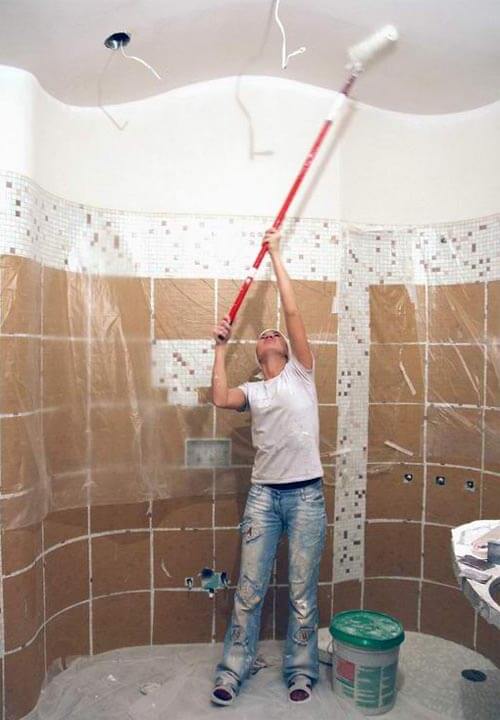
Painting work is not difficult, they do not require special professional skills:
Styrofoam cladding
Practical, easy to install material. A great example of which bathroom ceiling is better and cheaper than whitewash. Expanded polystyrene tiles fit especially well into a classic interior. The main advantage of the material is that it requires a minimum of time and effort to equip the ceiling. Tiles are simply glued to the concrete surface with liquid nails or all-purpose adhesive. Ceiling alignment is not necessary.
Ceiling made of plastic panels
This type of coating is the simplest version of a suspended ceiling. Unlike the previous options, this design requires a frame, as a result of which the height of the room is somewhat reduced.
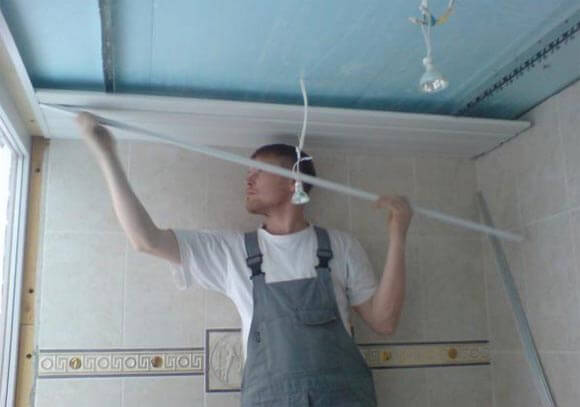
Installation of such a ceiling consists of several stages:
- First you need to assemble the frame on which they will be installed. It is mounted from a wooden bar or from a corrosion-proof metal profile.
- If you have chosen a timber, it must be treated with drying oil or a special synthetic compound to protect the wood from moisture.
- The frame slats are located at a distance of 50-60 cm from each other. The panels will be fixed perpendicular to the direction of the bars.
- After that, electrical wiring for ceiling lights is laid. It is recommended to put a waterproof corrugated tube on all wires.
- Finally, the panels are installed. They are fastened with self-tapping screws to the bars of the frame. On the side of the panels there is a groove with which they are connected, giving the impression that the ceiling consists of a solid piece of plastic.
- During installation, ceiling lights cut into the panels.
Magnesium glass ceiling
Glass-magnesium sheet (abbreviated LSU) has been used in interior decoration quite recently. If you are considering bathroom ceiling options, we recommend that you pay attention to this material. It resembles drywall, but compares favorably with it in greater plasticity, strength and ease of installation.
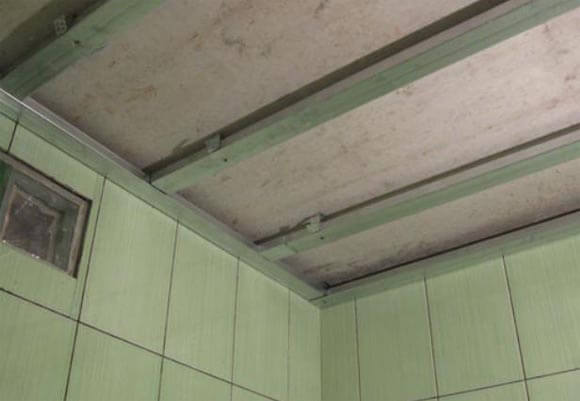
LSU does not pass or absorb moisture, which means it is great for finishing bathrooms and bathrooms. This coating, like any suspended structure, requires the creation of a frame. Installation of a glass-magnesium sheet is similar to the technology for installing a plasterboard ceiling. The frame in this case should be designed for a greater load than when using plastic panels.
After installation, this material is puttied and painted. The advantage over the usual painting of the ceiling is the ability to integrate fixtures into the suspended structure.
Cassette ceilings
The main advantage of rack and cassette aluminum structures is the ability to easily mount such a ceiling with your own hands without the involvement of professionals. Only the installation of the frame can be considered a relatively difficult stage of work. The panels themselves simply snap between the guide rails. It turns out a durable and beautiful coating without cracks.
The frame system of such ceilings is often made open. In this case, the frame slats become part of the decor. If you chose the closed option, then metal cassettes are installed on the frame using fasteners.
